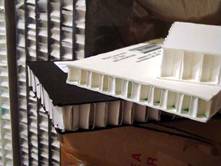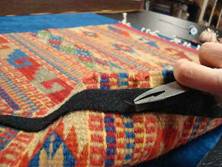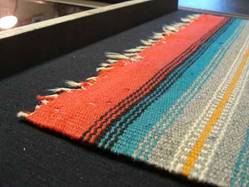 Photo 1
Photo 1
Hexamount and Tycore honeycomb boards
Two brightly colored Mexican rugs and a small antique family heirloom weaving needed to be prepared for display in a mountain log home. The rugs were never used, newly produced items, picked up in Mexico specifically as wall décor. Since these were new construction there were many design options available. The most cost effective way to display them would have been using a simple vertical hang with verso pocket or Velcro covered cleats. Nut since these were to be the major focal point of the rustic room they were to be framed horizontally and behind glazing. The family collectible was another story.
Substrate
The largest frame would be 38x65" and because of the weight and size of the rugs the selected substrate needed to be rigid and strong. In order to avoid white bleed a black color was also required for the mount board. Standard 40x60" oversized boards were not large enough nor were they the first board of choice. Black ½" Hexamount was a perfect choice but the 32x48" sheets—in stock—weren't large enough and the 48x96" boards required 5-sheet case purchase and even at that couldn't be delivered soon enough to meet the project deadline. This is a honeycomb centered, structural archival panel of 100% cotton rag surface paper that is available ½" thick up to 48x96" and ¾" thick up to 40x60" (photo 1). Tycore is another fabulous rigid, neutral pH honeycomb panel but is only available in natural white and is only available by the case. So, black ½" Gatorboard was chosen as the rigid alternative.
 Photo 1
Photo 1
Hexamount and Tycore honeycomb boards
Gator is not a preservation substrate because if its wood veneer layers top and bottom, but it's that veneer between the surface paper and foam center that gives the product its rigidity. And just as Hexamount or Tycore is resistant to warping unlike thinner rigid boards such as ¼" MightyCore. A thin ½" board with structural rigidity will withstand the rigors of wet adhesive, dry mounting and the added surface tension or a mounted fabric without a countermount required…even on a 4x8' project.
Fabric & Mounting
A 4" float space was designed surrounding the rug and the perfect color match to the blue in the weaving pattern was located in Durango Cobalt suede from Franks Fabrics. Since the fabric is prone to absorption it is best to use a wet/dry PVA mounting technique. The selection of Gator as a substrate would easily accommodate the mounting.
The 4x8' sheet of black ½" Gator were cut to actual size and the suede was cut about an inch larger around. Two coats of Franks Fabric PVA were evenly applied to the Gator with a sponge roller allowing to dry between coats. The fabric was aligned into one corner—aligning one long and one short side—then dry mounted to the dried PVA in a hot vacuum press at 200ºF degrees for four minutes. Since suede does not ravel and because of the shadowbox strips supporting the glazing, the edges of the covered substrate would never be visible so the fabric may be trimmed clean-cut to the actual edge of the Gatorboard and not wrapped around the edges.
Rug Mount
The design called for horizontal display of the rugs, so Velcro was hand sewn the full length of both top and bottom edges of each rug for stability, strength of mount, and to help secure it from touching the glazing. Because of the density and weight of the rug a black polyester thread was selected. By folding the thread in half and threading the folded end through the needle it becomes quadrupled. Then run the four ply thread through the edge of a cake of beeswax to unify the threads as one and strengthen them (photo 2). This is a common trick used in costume design for sewing on buttons and hemming. Using this strengthened thread the Velcro was then whip-stitched to the back top edge of the rug. Pliers and a metal thimble were needed to help sew through the Velcro (photo 3).
 Photo 2
Photo 2
Waxing the thread.
 Photo 3
Photo 3
Whip stitching hook Velcro along top verso edge of rug.
By placing the Velcro the same distance from the edge of the art, placement of the loop Velcro strip to be glued to the fabric substrate was easily aligned (photo 4). Begin by verifying rug placement on the backing, checking the float space surrounding the rug. Fold back the Velcro side and measure from rug edge to Velcro strip and add that to the float space distance. A faint white line was drawn on the suede to locate the placement for strip of loop Velcro.
 Photo 4
Photo 4
A fine white line is made at 4-¾" from substrate edge for placement of loop Velcro.
The bond between the polyester Velcro and the suede needed to be tear tested for strength prior to final bonding so a sampler was made from scraps to check the bond strength of both PVA and 3M Jet-Melt hot glue. The hot glue bond was chosen for speed of bond and strength. Once the top loop strip was attached the Velcro is fused and the bottom edge is lifted and the same placement process is repeated for bottom strip alignment and bonding.
Assembly & Fitting
The ½" Gatorboard was too thick to be used as the shadowbox side strips, so the polyester suede was PVA wet/dry mounted to ³⁄₁₆" black foam center board the length of the box. A single strip was mounted wide enough to allow for four ¾" wide strips to be cut the full length of the completed box (photo 5). This allowed for very cleanly cut strips that could easily be sized to fit snugly against the sides of the frame to hold the glazing in place (photo 6).
 Photo 5
Photo 5
Side strips were ³⁄₁₆" thick black foam center board.
 Photo 6
Photo 6
Strips were mounted, cut, and fitted to hold glazing.
There were twisted tassels at either end that were allowed to remain lose giving a more natural appearance. The 4" float space allowed plenty of room for the tassel ends while still creating a solid field of blue as a baseline for the rug to visually rest on. LJ 423440 Chestnut Verona moulding was selected for its natural and earthy wood tones and for the twisted inner lip detail that echoes both the twisted tassels and the picket fence short stripe design in the weaving(photo 7). The final rug frames were fitted with museum glass for protection and clarity (photo 8).
 Photo 7
Photo 7
Verona moulding pattern matches both tassel twist and vertical stripes in rug.
 Photo 8
Photo 8
Finished rugs for ready for installation.
Family Heirloom
The third piece was a small, delicate, lightweight, family heirloom Indian weaving which had numerous broken fibers and worn areas. Its colors, texture, weight and condition were very different from the new rugs. The same basic techniques were employed for this piece, but being much thinner and far more delicate it needed to be gentler handling. LJ 350790 Onyx Lucerne was chosen for the colors and Franks Fabric's Belmont Black linen was chosen as the backing fabric (photo 9). The same wet/dry PVA mounting was used for this substrate preparation and the side glazing supports were constructed also using the same methods.
 Photo 9
Photo 9
Black linen fabric and LJ Onyx Lucerne frame.
The Velcro was hand sewn with only doubled, waxed thread and smaller stitches for a more even distribution of tension on the weaving. Since the weaving was thin it settled into a valley between the Velcro strips when aligned onto the substrate, so the big difference was the addition of a double layer of white polyester felt behind the weaving to lift and support it (photo 10). This also gave the weaving a toothy surface to sit on making it far less able to stretch or shift. Any distortion of the support surface showed under the weaving, so the felt was placed just inside the strips of Velcro—with no gap—but not overlapping it. This evenly lifted and supported it giving it the appearance of floating over the linen backing (photo 11).
 Photo 10
Photo 10
Polyester felt was fitted behind and between the Velcro.
 Photo 11
Photo 11
The final presentation had the appearance of floating.
The final shadowbox rug frames were 38x65" and 31x47" and the small antique weaving was 22x24" were all fitted with museum glass, delivered and installed for his housewarming party. This is a high end solution that fit both the contemporary rugs and the cherished family heirloom. Though there were two different situations—one with weight, the other with delicacy—the same principles were used with only slight variations to accommodate individual issues. Obviously, Hexamount would have been the more sound preservation choice, but Gatorboard provided the rigidity and strength required for this project in the time allowed.
Even though the rugs were purchased by a friend in Mexico—so not collected from a memorable vacation—they were treated in the manner of all high end fine art. This is another good example of framing to meet the client's desires and not for the actual value of the art.
END
Copyright © 2012 Chris A Paschke
For more articles on mounting basics look under the mounting section in Articles by Subject.
Additional information on all types of mounting is found in:
The Mounting and Laminating Handbook, Second Edition, 2002,
The Mounting And Laminating Handbook, Third Edition, 2008 and
Creative Mounting, Wrapping, And Laminating, 2000 will teach you everything you need to know about getting the most from your dry mount equipment and materials as an innovative frame designer.
All books are available from Designs Ink Publishing through this website.
Chris A Paschke, CPF GCF
Designs Ink
Designs Ink Publishing
785 Tucker Road, Suite G-183
Tehachapi, CA 93561
P 661-821-2188
chris@designsinkart.com